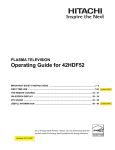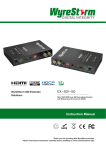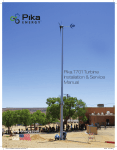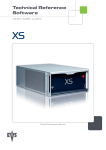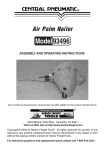Download XL[2] Technical Reference – Hardware
Transcript
Technical Reference Hardware Version 10.01 - May 2009 Production Proxy Server XL Series DISK RECORDER - Version 10.01 - Hardware Technical Reference Manual Issue 10.01.A EVS Broadcast Equipment SA – May 2009 Copyright EVS Broadcast Equipment – Copyright © 2009. All rights reserved. Disclaimer The information in this manual is furnished for informational use only and subject to change without notice. While every effort has been made to ensure that the information contained in this user manual is accurate, up-to-date and reliable, EVS Broadcast Equipment cannot be held responsible for inaccuracies or errors that may appear in this publication. Improvement Requests Your comments will help us improve the quality of the user documentation. Do not hesitate to send improvement requests, or report any error or inaccuracy on this user manual by e-mail to [email protected] . I Issue 10.01.A XL Series DISK RECORDER - Version 10.01 - Hardware Technical Reference Manual EVS Broadcast Equipment SA – May 2009 Table of Contents TABLE OF CONTENTS .................................................................................................... II 1. OVERVIEW............................................................................................................... 1 1.1 UNPACKING................................................................................................................................1 1.2 DIMENSIONS ..............................................................................................................................2 1.3 INSTALLALTION..........................................................................................................................3 1.4 SAFETY, COMPLIANCE AND OPERATING CONDITIONS........................................................4 1.4.1 Safety......................................................................................................................................4 1.4.2 EMC Standards.......................................................................................................................4 1.4.3 EMC Warning..........................................................................................................................5 1.4.4 CE Marking .............................................................................................................................6 1.4.5 Power Supply..........................................................................................................................6 Cold Swap..................................................................................................................................................................6 Hot Swap....................................................................................................................................................................7 Secondary Power Supply ...........................................................................................................................................8 Grounding ..................................................................................................................................................................8 1.5 VENTILATION & RACK MOUNTING ...........................................................................................8 1.6 XL[2] SERVER MAIN SPECIFICATIONS ....................................................................................9 1.6.1 Video.......................................................................................................................................9 1.6.2 Audio.......................................................................................................................................9 1.6.3 Video Codecs & Bitrates .........................................................................................................9 1.6.4 Recording Capacity for XL[2] Servers ...................................................................................10 1.6.5 Supported SMPTE Standards...............................................................................................10 1.6.6 Maximum Bitrate values........................................................................................................10 1.6.7 Raid level: 3 ..........................................................................................................................10 1.6.8 Interpolation ..........................................................................................................................11 2-line Interpolator .....................................................................................................................................................11 4-line Interpolator .....................................................................................................................................................12 2. CABLING................................................................................................................ 13 2.1 XL[2] 6U BACK PLANE..............................................................................................................13 2.2 AUDIO CONFIGURATIONS ......................................................................................................13 2.2.1 CODA A2 ..............................................................................................................................13 2.3 CONNECTION BETWEEN XL[2] AND XT[2] .............................................................................14 2.4 CONNECTION BETWEEN MULTIPLE XL[2] SERVERS ON XNET..........................................14 2.4.1 Connection Diagram without EVS XHub SDTI HUB .............................................................16 2.4.2 Connection Diagram With EVS XHub SDTI HUB..................................................................17 2.4.3 Required conditions to set up and run XNet..........................................................................17 2.4.4 Starting XNet.........................................................................................................................19 2.4.5 XNet Performances & Troubleshooting.................................................................................19 2.5 GIGABIT CONNECTION............................................................................................................20 3. HARDWARE DESCRIPTION ................................................................................. 21 3.1 SLOT CONFIGURATION...........................................................................................................21 3.2 VIDEO AND REFERENCE BOARDS ........................................................................................21 3.2.1 COHX Board .........................................................................................................................21 Jumpers on the COHX base module .......................................................................................................................22 II XL Series DISK RECORDER - Version 10.01 - Hardware Technical Reference Manual Issue 10.01.A EVS Broadcast Equipment SA – May 2009 Leds on the COHX base module with gunlock.........................................................................................................23 Leds on the COD A and COD B modules (from left to right)....................................................................................23 Connectors on the COD A and COD B modules .....................................................................................................24 Channel Assignment ................................................................................................................................................25 3.3 AUDIO CODEC BOARD ............................................................................................................26 LED information and connector................................................................................................................................26 3.4 RAID CONTROLLER BOARDS .................................................................................................27 3.4.1 HCTX board ..........................................................................................................................27 Jumpers ...................................................................................................................................................................28 LEDs ........................................................................................................................................................................28 Connectors...............................................................................................................................................................29 Gigabit Connectors ..................................................................................................................................................30 3.4.2 RTCL Board on Disk Array (with HCTX) ...............................................................................30 LEDs ........................................................................................................................................................................31 3.5 MTPC BOARD ...........................................................................................................................32 3.5.1 A2/A4 Board..........................................................................................................................33 LED information: ......................................................................................................................................................34 Board configuration: .................................................................................................................................................34 III XL Series DISK RECORDER - Version 10.01 - Hardware Technical Reference Manual Issue 10.01.A EVS Broadcast Equipment SA – May 2009 1. Overview Welcome in the EVS range of products and thank you for using an EVS XL[2] server. We will do our best to satisfy your video production needs and we look forward to continuing working with you. The EVS XL[2] servers ar e full digital in PAL (625i), NTSC (525i). Developed to work as a complement to t he XT[2] production server, which allows users to work in high resolution media in either SD or HD, the XL[2] server is the ideal solution for large studio and major events production. The XL[2] server allows ingesting the media in low resolution, in parallel with the ingest on the XT[2] server. The users can then browse or review the lowresolution ingested media through the gigabit Ethernet connection to keep the production running smoothly. The XL[2] server is controlled by EVS’ IPDirector or through EVS open AVSP protocol. 1.1 UNPACKING On receipt of the equipment examine packi ng for obvious signs of damage. If damaged, do not unpack and inform the carrier immediately. Check thanks to the included packing list if all the items are present and if they show any mechanical damage. If yes, report damage or the missing parts to EVS or their appropriate representative. 1 Issue 10.01.A XL Series DISK RECORDER - Version 10.01 - Hardware Technical Reference Manual EVS Broadcast Equipment SA – May 2009 1.2 DIMENSIONS Video disk recorder Main frame 19 inches Rack mount 6U – Weight: 32.5 Kg/ 71.5 Lbs. The following table specifies the various lengths: Cold swap (without redundant power supply) 2 Description Length (mm) Length (inch.) Rackable length (from behind the rack mounting stripes to the back of the server) 603 23,7 Length without the front panel 627 24,7 Length with the handles 660 26,0 Length with the front panel 670 26,4 XL Series DISK RECORDER - Version 10.01 - Hardware Technical Reference Manual Issue 10.01.A EVS Broadcast Equipment SA – May 2009 Hot swap (with redundant power supply) Description Length (mm) Length (inch.) Rackable length (from behind the rack mounting stripes to the back of the server) 640 25,2 Length without the front panel 662 26,1 Length with the handles 695 27,4 Length with the front panel 705 27,7 Hot swap power supplies sticks out by 25mm / 1’’ (H: 187mm / 7.2’ by W: 170mm / 6.65’) Rack mounting stripes: L: 270 mm / 10.6” by W 21 mm / 0.8” Handles: H: 55mm / 2.2” by L: 160 mm / 6.3” by W: 21 mm / 0.8” Keyboard - Weight: 0.4 Kg / 0.9 Lbs. 1.3 INSTALLALTION Important Verify the disk recorder unit has the correct voltage specifications for your power source prior to applying power. (selectable 110/230 VAC on the rear panel of the power supply, or autoswitch, depending on the type of power supply unit installed) Main power switch is located at the front side (lower right corner) of the unit. Before turning on the power, open the front door of Video disk recorder unit to check if all boards fit into their guides. If a board is out of its guides, remove carefully the board and replace it in the same slot. 3 Issue 10.01.A XL Series DISK RECORDER - Version 10.01 - Hardware Technical Reference Manual EVS Broadcast Equipment SA – May 2009 1.4 SAFETY, COMPLIANCE AND OPERATING CONDITIONS 1.4.1 SAFETY This equipment has been designed and tested to meet the requirements of the following: EN 60950 European Safety of information technology equipment including business equipment. IEC 950 International Safety of information technology equipment including business equipment. In addition, this equipment has been designed to meet the following: UL 1950 - USA 1.4.2 4 USA Safety of information technology equipment including business equipment EMC STANDARDS EN 55022 European Emission Standard EN 61000-3-2 European Electromagnetic Compatibility (EMC) Part 3 (Limits); Section2 ; limits for harmonic current emissions (equipment input current <16A per phase) EN 61000-3-3 European European Electromagnetic Compatibility (EMC) Part 3 (Limits), Section 3; limitation of voltage fluctuation and flicker in low-voltage supply systems for equipment with rated current of 16 A. EN 61000-4-3 European European Electromagnetic Compatibility (EMC) Part 4 (Limits), Section 3; Testing and measurement techniques - Radiated, radio-Frequency, electromagnetic field immunity test. EN 61000-4-4 European European Electromagnetic Compatibility (EMC) Part 4 (Limits), Section 4; Testing and measurement techniques - Electrical fast transient/burst immunity test. EN 61000-4-5 European European Electromagnetic Compatibility (EMC) Part 4 (Limits), Section 5; Testing and measurement techniques - Surge immunity test. XL Series DISK RECORDER - Version 10.01 - Hardware Technical Reference Manual Issue 10.01.A EVS Broadcast Equipment SA – May 2009 1.4.3 EN 55022 European Emission Standard EN 61000-4-6 European European Electromagnetic Compatibility (EMC) Part 4 (Limits); Section 6 ; Testing and measurement techniques - Immunity to conducted disturbances, induced by radio-frequency fields. EN 61000-4-7 European European Electromagnetic Compatibility (EMC) Part 4 (Limits), Section 7; harmonics and interharmonics measurements and instrumentation, for power supply systems and equipment connected thereto. EN 61000-4-11 European European Electromagnetic Compatibility (EMC) Part 4 (Limits); Section 11 ; Voltage dips, short interruptions and voltage variations immunity tests. EN 50082-1 European European Generic Immunity Standard – Part 1: Domestic, commercial and light industry environment. FCC USA Conducted and radiated emission limits for a Class A digital device, pursuant to the Code of Federal Regulations (CFR) Title 47 – Telecommunications, Part 15: Radio Frequency devices, subpart B-Unintentional Radiators. EMC WARNING Changes or modifications not expressly approved by the manufacturer for compliance could void the user's authority to operate the equipment. This equipment has been tested and found to comply with the limits for a Class B digital device, pursuant to Part 15 of the FCC Rules. These limits are designed to provide reasonable protection against harmful interference in a residential installation. This equipment generates uses and can radiate radio frequency energy and, if not installed and used in accordance with the instructions, may cause harmful interference to radio communications. However, there is no guarantee that interference will not occur in a particular installation. If this equipment does cause harmful interference to radio or television reception, which can be determined by turning the equipment off and on, the user is encouraged to try to correct the interference by one or more of the following measures: • Reorient or relocate the receiving antenna • Increase the separation between the equipment and receiver • Connect the equipment into an outlet on a circuit different from that to which the receiver is connected • Consult the dealer or an experienced radio/TV technician for help 5 Issue 10.01.A XL Series DISK RECORDER - Version 10.01 - Hardware Technical Reference Manual EVS Broadcast Equipment SA – May 2009 1.4.4 CE MARKING The CE marking is affixed to indicate compliance with the following directives: • 89/336//EEC of 3 May 1989 on the approximation of the laws of the Members States to electromagnetic compatibility. • 73/23/EEC of 19 February 1973 on the harmonization of the laws of the Members States relating to electrical equipment designed for use within certain voltage limits. • 1999/5/EC of 9 March 1999 on radio equipment and telecommunications terminal equipment and the mutual recognition of their conformity. 1.4.5 POWER SUPPLY C OLD S WAP This equipment is fitted with a wide-ranging power supply. It is suitable for supply voltages of 100 to 240 Vac -10%+6% at 50 or 60 Hz nominal. Connection to supply: Pluggable equipment Type A (EN60950 §1.2.5): Equipment which is intended for connection to the building power supply wiring via a non-industrial plug and socket-outlet or a non-industrial appliance coupler or both. Correct mains polarity must always be observed. Do not use reversible power plugs with this equipment. Class of equipment: Class 1 equipment (EN60950 § 1.2.5): electric shock protection by basic insulation and protective earth. Rated voltage: 110 to 240Vac (single phase) Rated frequency: 50/60 Hz Related Current: 10 A (100 to 120 Vac range) 5 A (220 to 240 Vac range) Input connector: CEE22/IEC 320 3-pin male receptacle 6 XL Series DISK RECORDER - Version 10.01 - Hardware Technical Reference Manual Issue 10.01.A EVS Broadcast Equipment SA – May 2009 Environmental conditions The equipment should be kept in the following environmental conditions: Temperature: 0°C to +40°C (32°F to 104°F) ambient with free air flow Relative humidity: 0% to 90% (non-condensing) Cooling requirements: Forced air cooling air flow from front to back Handling/movement: Designed for fixed use when in operation Storage and transportation temperature: 0°C to +70°C (32°F to 158°F) Storage and transportation relative humidity: 0% to 90% (non-condensing) H OT S WAP This equipment is fitted with a wide-ranging power supply. It is suitable for supply voltages of 115 to 240 Vac +/-10% at 47 or 63 Hz nominal. Connection to supply: Pluggable equipment Type A (EN60950 §1.2.5): Equipment which is intended for connection to the building power supply wiring via a non-industrial plug and socket-outlet or a non-industrial appliance coupler or both. Correct mains polarity must always be observed. Do not use reversible power plugs with this equipment. Class of equipment: Class 1 equipment (EN60950 § 1.2.5): electric shock protection by basic insulation and protective earth. Rated voltage: 115 to 240Vac (single phase) Rated frequency: 47/63 Hz Related Current: 8 A (100 to 120 Vac range) 4 A (220 to 240 Vac range) Input connector: CEE22/IEC 320 3-pin male receptacle Environmental conditions Temperature: 0°C to + 50°C (32°F to 104°F) ambient with free air flow Relative humidity: 0% to 90% (non-condensing) Cooling requirements: Forced air cooling air flow from front to back Handling/movement: Designed for fixed use when in operation Storage and transportation temperature: 0°C to +70°C (32°F to 158°F) Storage and transportation relative humidity: 0% to 90% (non-condensing) 7 Issue 10.01.A XL Series DISK RECORDER - Version 10.01 - Hardware Technical Reference Manual EVS Broadcast Equipment SA – May 2009 S ECONDARY P OWER S UPPLY Cold swap 2 n d Power Supply A 2 n d power supply (cold swap) for the disk recorder unit is available optionally. To connect this 2 n d power supply in case of failure of the main one, remove the metal plate in the top right corner of the back panel, and swap the large electrical connector located inside this compartment. This additional power supply should not be connected to mains when not in use. Hot swap 2 n d Power Supply A 2 n d power supply (hot swap) for the disk recorder unit is available optionally. This additional power supply should be connected to mains to allow automatic power switching to the second power supply would the first one fail. The remote panel, the touch screen and the external ADA rack are fitted with an AUTOSWITCH power supply. A 2 n d power supply (hot swap) for the disk recorder unit is available optionally. This additional power supply should be connected to mains to allow automatic power switching to the second power supply would the first one fail. G ROUNDING Ensure the disk recorder unit is properly grounded at all times to avoid electrical shock hazard. 1.5 VENTILATION & RACK MOUNTING Adequate ventilation is obviously required for optimum performance. As result of this consideration, ensure no other equipment is located close to the mainframe. Important • Remember that fans are used to air cool the equipment and protect it from overheating. • Do not block fans intakes during operations. Having regard to the weight of the XL[2] chassis, support guides are required for this unit into the rack mount. The front ears of the XL[2] unit are not designed to support its full weight. Applying full weight on these might result in bending the metal plate. 8 XL Series DISK RECORDER - Version 10.01 - Hardware Technical Reference Manual Issue 10.01.A EVS Broadcast Equipment SA – May 2009 1.6 XL[2] SERVER MAIN SPECIFICATIONS 1.6.1 VIDEO Video Formats 1.6.2 XL[2] Server Standard Definition 525i 59.94fps (NTSC) 625i 60fps (PAL) Digital Interface 10-bit 4:2:2 Serial (SMPTE259M). Full frame synchronizer at input. Number of channels (6RU rack) Monitoring & Down-converters 6 REC channels, Reference Analogue Black Burst 1 CVBS or SDI (software select) per channel, with OSD AUDIO • up to 8 embedded audio channels per video • no AES or analogue audio connector on mainframe Audio Processing • uncompressed audio • 20 or 24 bit processing and storage • audio scrub 1.6.3 VIDEO CODECS & BITRATES The EVS XL[2] server uses an intra-frame video encoding technique. The XL[2] server supports natively the MJPEG (SD) video codec. The target bitrate of the encoded video stream can be set by the user within the accepted range: 1 to 6 Mbps for standard definition. The default values are MJPEG 3 Mbps for standard definition. 9 Issue 10.01.A XL Series DISK RECORDER - Version 10.01 - Hardware Technical Reference Manual EVS Broadcast Equipment SA – May 2009 1.6.4 RECORDING CAPACITY FOR XL[2] SERVERS The following tables show the record duration for 1 record channel (i.e. 1 video + 2 stereo audio tracks in SD) with arrays of 300GB disks. These tables are valid with the “ Operational Disk Size” parameter set to 100%. The typical drive arrangement is an Internal/External module (4 + 1) x 300 GB drives (total 1200 GB usable). Compression + Bitrate + Audio Nr. MJPEG / 3 Mbps / 4 audios MJPEG / 3 Mbps / 8 audios MJPEG / 3 Mbps / 16 audios Disk Size 5x300GB 365 h 227 h 129 h NTSC Compression + Bitrate + Audio Nr. MJPEG / 3 Mbps / 4 audios MJPEG / 3 Mbps / 8 audios MJPEG / 3 Mbps / 16 audios Disks Size 5x300GB 367 h 228 h 130 h PAL 1.6.5 SUPPORTED SMPTE STANDARDS The following standards are supported: 1.6.6 SD SDI SMPTE 259M (525i 625i) LTC SMPTE 12M D-VITC SMPTE 266M Vertical Ancillary Data SMPTE 334M MAXIMUM BITRATE VALUES The maximum bitrate is 6 Mbps. This maximum value is valid for XL[2] servers running Multicam version 10.00.xx or higher. 1.6.7 RAID LEVEL: 3 The Video Raid uses striping process across 5 disk drives. The video and audio data is striped over the first 4 drives while the parity information is saved on the 10 XL Series DISK RECORDER - Version 10.01 - Hardware Technical Reference Manual Issue 10.01.A EVS Broadcast Equipment SA – May 2009 fifth drive. If one drive is damaged, the Video Raid can use the parity information to recover the missing information, so that operation can continue seamlessly without bandwidth loss. For more information on online rebuild, refer to the section dedicated to this subject in the XT Technical Reference Software manual. 1.6.8 INTERPOLATION The playing back of smooth slow motion pictures carries specific issues: since some fields must be repeated at regular interval to provide the video at the playback speed required by the operator, parity violation appears regularly on the output video signal. This issue is specific to interlaced formats (525i, 625i and 1080i) and does not concern progressive formats (720p). If O and E represent respectively the odd and even fields of a standard video signal (50/60 Hz), we have: The original video signal: O E O E O E O E O E O E O E O E The output video signal at 50% speed: O O E E O O E E O O E E O O E E The output video signal at 33% speed: O O O E E E O O O E E E O O O E The output video signal at 25% speed : O O O O E E E E O O O O E E E E Fields with parity violation are shown in bold, underlined letters. As it appears from the above table, whatever the playback speed (with the exception of the normal 100% playback speed), a number of fields violate the normal parity of the output signal. This parity violation induces a 1-line shift of the field, resulting in a vertical jitter of the picture. The jitter frequency depends upon the chosen playback speed. To avoid this phenomenon and provide a stable output picture, EVS developed 2 types of line interpolator: 2-line and 4-line interpolators. The interpolation process can be enabled or disabled by the operator on all EVS slow motion systems. 2- LINE I NTERPOLATOR The 2-line interpolator actually generates a new field, when the original field is in parity violation. Each line of this new field is calculated by a weighted average of the 2 neighbouring lines. This process solves the problem of parity violation and vertical jitter, but the drawback is a reduction of the vertical resolution on the interpolated fields, that appear unfocused. Another by-side effect is the alternation of original fields (perfectly focused) and interpolated fields (unfocused), resulting in a "pumping" video signal. 11 Issue 10.01.A XL Series DISK RECORDER - Version 10.01 - Hardware Technical Reference Manual EVS Broadcast Equipment SA – May 2009 4- LINE I NTERPOLATOR The 4-line interpolator uses a more sophisticated calculation based on the 4 neighbouring lines. By using suitable coefficients for the weight of each line in the resulting calculation, we apply this interpolation to all fields. The final result is a permanently, slightly unfocused picture. The advantage is a stable output signal with no jitter and no "pumping", but the vertical bandwidth is even more reduced. The interpolator is of course always disabled at 100% playback speed, because there is no parity violation. Whatever the choice, the resulting picture is thus always a compromise between stability and resolution . With EVS systems, the operator always has got the choice between any of the 3 above described techniques: no interpolation, 2-line interpolation or 4-line interpolation. Even if the operator chooses to use the interpolation, this process will be automatically disabled when not necessary (100% playback for 50/60 Hz signal. Note All professional VTRs use line interpolation in PlayVar mode to avoid vertical jitters. Default value is interpolator off for all configurations. 12 XL Series DISK RECORDER - Version 10.01 - Hardware Technical Reference Manual Issue 10.01.A EVS Broadcast Equipment SA – May 2009 2. Cabling 2.1 XL[2] 6U BACK PLANE 2.2 AUDIO CONFIGURATIONS 2.2.1 CODA A2 Internal Audio Module: Embedded Audio only • 2 Embedded audio groups (8 mono channels) per video channel • Audio Monitoring: 4 analogue balanced mono outputs (XLR) 13 Issue 10.01.A XL Series DISK RECORDER - Version 10.01 - Hardware Technical Reference Manual EVS Broadcast Equipment SA – May 2009 2.3 CONNECTION BETWEEN XL[2] AND XT[2] The SDI inputs of the low-resolution server will come from the loop of the recorders of the corresponding XT[2] server that will run either SD or HD. High-Resolution Server (XT[2]) Low-Resolution Server (XL[2]) IN IN OUT J1 J4 In case the high-resolution server is in HD, you need to ensure that the REC HDÎ SD Low Latency parameter defined on the high-resolution XT[2] in the EVS Advanced Parameters is set to ‘ON ’. This parameter takes into account the oneframe delay between the HD IN (J8) connector and the SD OUT (J3) connector that feeds the XL[2] server. The VITC and embedded audio information is kept. The LTC and genlock inputs will need to be cabled in the XL[2] and the XT[2] servers. 2.4 CONNECTION BETWEEN MULTIPLE XL[2] SERVERS ON XNET In major events production where the media is ingested in low-resolution in parallel to the high-resolution ingest, each XL[2] is connected to an XT[2]. The XL[2] servers and XT[2] servers have their own independent XNet network, as well as an independent gigabit Ethernet network. The following schema represents such a setup: 14 XL Series DISK RECORDER - Version 10.01 - Hardware Technical Reference Manual Issue 10.01.A EVS Broadcast Equipment SA – May 2009 The XNet network is composed by several XL[2] systems all connected with a 75Ohm coaxial cable (BNC). The exchange between systems is operated through the SDTI interface at 540 or 1485 Mbps. On XL[2] servers there are two pairs of SDTI connectors: • XNet Relay connectors can be used at a maximum speed of 540 Mbps. • XNet[2] Non-Relay connectors can be used at 540 or 1485 Mbps. When connected on the SDTI network through Relay connectors, the SDTI loop is always established, even if the XL[2] is not powered on. When connected through Non-Relay connectors, the SDTI loop is closed only when the Multicam software is started. It is therefore recommended to use XHub when using Non-Relay connectors to avoid network interruptions. The XNet requires a network server dedicated to the management of the Database shared among all XL[2]s. This is assigned to one of the XL[2] systems on the network. The XL[2] acting as the network server can of course be used for standard LSM/video server operation. 15 Issue 10.01.A XL Series DISK RECORDER - Version 10.01 - Hardware Technical Reference Manual EVS Broadcast Equipment SA – May 2009 2.4.1 16 CONNECTION DIAGRAM WITHOUT EVS XHUB SDTI HUB XL Series DISK RECORDER - Version 10.01 - Hardware Technical Reference Manual Issue 10.01.A EVS Broadcast Equipment SA – May 2009 2.4.2 CONNECTION DIAGRAM WITH EVS XHUB SDTI HUB 2.4.3 REQUIRED CONDITIONS TO SET UP AND RUN XNET 1. All systems on the network must be XL [2] servers, XFile[2] or XF[2], XStore[2] or XHub[2]. 2. The SDTI advanced option code (for network client, master or server modes) must be validated in the options list. 3. They should all be running c ompatible software version. A warning message is displayed when trying to connect an XL[2] system with a software version that is not compatible with the network server. 4. The following parameters must be similar on all systems : a. SDTI Speed (usually 540Mbps or 1485Mbps, from Hardware Configuration menu) 17 Issue 10.01.A XL Series DISK RECORDER - Version 10.01 - Hardware Technical Reference Manual EVS Broadcast Equipment SA – May 2009 b. Number of clips 5. Network Type must be set to “ Server” on 1 XL[2] (and only 1) on the network. The others must be set to either “ M aster” (to share clips and view others’ clips) or “ Client” (to share clips only). 6. A different network number must be specified for each XL[2] system that you want to connect to the network. If the same network number is assigned to 2 different systems, the second one will not be able to connect and a warning message will be displayed. 7. All XL[2]s must be connected with a good quality BNC 75O-hm cable to form a closed loop. Connect the SDTI OUT connector of the first XL to the SDTI IN connector of the second one, etc. until the loop is closed by connecting the SDTI OUT connector of the last XL to the SDTI IN connector of the first one. The SDTI loop must be closed at all times during network operation. If for any reason the loop is open, all network communication will be interrupted and all systems will automatically switch to stand alone mode. When the loop is closed again, network operation will resume auto matically. This problem can be avoided or limited using EVS XHub SDTI hub. 8. The distance shown in the table below is the ma ximum cable length between two active EVS servers, or 2 SDTI reclockers, on an XNet SDTI network, using a single piece of cable between 2 servers or 2 reclockers. Intermediate connectors, patch panels, etc., might degrade these figures. Depending on the number of servers connected on the network, the location of the master server, the presence or not of an XHub SDTI hub, the actual m aximum values may be high er than indica ted. If longer di stances between servers are required , SDTI to fibre converters can be used, allowing distances over tho usands of meters if ne cessar y. EVS has va lidated the following SDI-fibre con verters: a. Stratos Lightwave M edia (www.stratoslightwave.com) Converter TX/RX VMC-T-H-2/VMC-R-H-2 b. Telecast TX/RX292 (www.telecast-fiber.com ) c. Netw ork E lectronics SDI -EO-1 3T (electrical t o optical) / SDI-OE-S (optical to electrical) (www.network-electronics.com) d. Network Electronics HD-EO-13T (electrical to optical / HD-OE (optical to electrical) e. BlueBell BB320T (TX) and B B320R (RX) ( www.bluebell.tv) Cable type @ 1485 Mbps @ 540 Mbps RG59 45m / 148ft 100m / 328ft RG6 90m / 484ft 180m / 590ft RG11 120m / 393ft 250m / 820ft Super HiQ 150m / 492ft 350m / 1148ft Fiber 80km(*) 200km(*) (*) 80km/200km is the total length of the return path, i.e. the actual distances between the 2 servers connected via the fiber link is half of this value, i.e. 40 km @ 1485Mbps, 100 km @ 540Mbps. 18 XL Series DISK RECORDER - Version 10.01 - Hardware Technical Reference Manual Issue 10.01.A EVS Broadcast Equipment SA – May 2009 Note When reclockers are used, the total delay induced by these reclockers between 2 active servers on the network may not exceed 15 μs. 2.4.4 STARTING XNET 1. When all above conditions are fulfilled, turn on all “ M asters” and “ Clients” XL[2]s, and make sure the Multicam application is started on all of them. A message appears bec ause they are looking for the “ Server” XL[2]. 2. Turn on the “ Server” XL[2] and start the Multicam application. The other XL[2]s should see the “ Server” arriving on the n etwork and will connect automatically. Connection takes a few seconds (usually between 2 and 5 sec) for each XL[2]. 2.4.5 XNET PERFORMANCES & TROUBLESHOOTING 1. With the default settings, 10 real-time transfers can be achieved on the network with standard definition pictures in normal conditions, and 3 real-time transfers with super motion pictures. Copy of a clip between 2 servers on the network can be made up to 5 times faster than real time, depending on network occupancy. With high definition pictures, these numbers are reduced to 3-4 real-time transfers and copy clip 2 times faster than real time. These performances are also limited by the disk bandwidth available from the XL[2] where the clips are stored. If the XL[2] “ owning” the clips is doing multiple playbacks at the same time, freezes can occur on the remote XL[2] using those clips. Priority levels have been implemented to maximize network bandwidth efficiency: PLAY requests have a higher priority than SEARCH/BROWSE requests, which in turn have a higher priority than COPY requests. Note that “ Live” (E2E) mode on a remote record train has the same priority level as a SEARCH/BROWSE request. 2. Note that when working at 1485Mbps or 540Mbps, only passive SDI routing equipment may be used. The use of active SDI equipment should be avoided, because they could cause additional line delays and prevent the proper operation of XNet. 3. If the start-up of the network at a specific speed does not work properly and all machines are apparently configured properly and the Multicam is actually started on all of them, this can be due to the fact that the selected cables to connect all XL[2]s together are not suitable or too long to operate at such a speed. You can decrease the speed of the SDTI network on all machines and try working in this mode. The number of simultaneous real-time transfers you can achieve is of course reduced. 19 Issue 10.01.A XL Series DISK RECORDER - Version 10.01 - Hardware Technical Reference Manual EVS Broadcast Equipment SA – May 2009 4. While working at 1485 Mbps, if the connection cannot be established, please make sure that all equipments are set to the same speed and connected to the non-relay connectors. All equipments should be started if not connected to an XHub. 5. It is recommended to use XHub if the network speed is set to 1485 Mbps. 6. Once the network has been established, if the system acting as the network server is disconnected or shut down, another system will automatically be assigned to act as a new network server. The switch is automatic and seamless. The next machine to be automatically assigned as new network server is the one with the highest serial number in the SDTI network. 2.5 GIGABIT CONNECTION The Gigabit connection between the XL[2] servers is only used for browsing purposes by IPDirector. It is not used to transfer video and audio material to external systems since the diffusion and archiving are performed on the high resolution material. For more information on the GigE network setup, refer to the EVS Support team. 20 XL Series DISK RECORDER - Version 10.01 - Hardware Technical Reference Manual Issue 10.01.A EVS Broadcast Equipment SA – May 2009 3. Hardware Description 3.1 SLOT CONFIGURATION The EVS Disk Recorder contains all the EVS developed boards. 6U Frame Slot # 9 8 7 6 5 4 3 2 1 XL[2] Disk Array HCTX CODA (Audio Codec) (empty) COHX Proxy #3 COHX Proxy #2 (empty) COHX Proxy #1 Genlock MTPC 3.2 VIDEO AND REFERENCE BOARDS 3.2.1 COHX BOARD The COHX board is divided in 3 parts: COHX base (centre front and back), COD A module (front left), and COD B module (front right). COD A and COD B modules are the actual CODEC modules, each of them being able to be configured by software as an encoder (for a record channel). There are 2 versions of the COHX base : one with genlock, one without genlock. The genlock model can easily be identified by the presence of 3 quartz synthesizer at the back of the board, on the right-hand side, and by the presence of the GLK and PSU OK LEDs on either side of the DIN connector at the centre front of the board. Note that a COHX board with genlock must be installed as COHX #1 in first position (slot 2) in an XL[2] system. A COHX board with genlock can never be installed in any other slot, and thus can not be used instead of COHX #2 or #3. Doing so will result in conflicting electrical signals inside the system. 21 Issue 10.01.A XL Series DISK RECORDER - Version 10.01 - Hardware Technical Reference Manual EVS Broadcast Equipment SA – May 2009 J UMPERS ON THE COHX BASE MODULE ST1, ST2: These 2 jumpers must be installed on the last COHX board of the server (i.e. on COHX #1, 2 or 3 if there are respectively 1, 2 or 3 COHX board installed in the server) ST3 (SPARE): « parking » for jumpers for ST1 and ST2 when these are not used ST4 (only on COHX with genlock) : It must be set to HiZ (or not installed). ST5 : It defines the position of the board inside the server. Note that the Genlock Loop connector on the back panel of the XL[2] server must always be terminated with a 75 Ohm load if it is not used. It must be set to « 1 » for a COHX with genlock, and to « 2 » or « 3 » for a COHX board without genlock, depending on its position in the server. 22 XL Series DISK RECORDER - Version 10.01 - Hardware Technical Reference Manual Issue 10.01.A EVS Broadcast Equipment SA – May 2009 L EDS ON THE COHX BASE MODULE WITH GUNLOCK GLK Off when the genlock module is not initialized Blinks green when the genlock module is properly initialized, but not valid genlock signal is detected On, steady green when the module is initialized and a valid genlock signal is detected Red (intermittent) when there is a genlock problem Red (steady) when a resync is needed PSU OK On (green) when all voltages are present and in the allowed range, otherwise the led is off L EDS ON THE COD A AND COD B MODULES ( FROM LEFT TO RIGHT ) CPU Blinks green to indicate CPU activity On, steady green when there is a problem with the processor of the COD module PLAY On (green) when the COD module is set by the software in play mode Off when the COD module is set in record mode PVID on (green) when a valid video signal has been detected on the J8 connector (SD/HD SDI input), whether the COD module is in play or record mode 23 Issue 10.01.A XL Series DISK RECORDER - Version 10.01 - Hardware Technical Reference Manual EVS Broadcast Equipment SA – May 2009 TF (transfer) Blinks green while data transfers occur between the COD module and the HCTX board M1, M2, not yet used M3, M4 C ONNECTORS ON THE COD A AND COD B MODULES Connector J1 SD mode SDI/CVBS (*) monitoring output (SD) Connector label on rear panel Character Outs, CVBS/SDI J4 SDI monitoring output (SD) Character Outs, SD SDI input J8 (SD) SD IN (*) The switch between SDI and CVBS on J1 is done by a software setting in the EVS Configuration menu. The following schema shows the connector positions: 24 XL Series DISK RECORDER - Version 10.01 - Hardware Technical Reference Manual Issue 10.01.A EVS Broadcast Equipment SA – May 2009 Note Only front backplanes labelled BKP7 are compatible with COHX boards (7 slots for 6U frames). The BKP7 backplanes (compatible with COHX boards) have 3 rows of soldering per slot, while the backplanes compatible with IO-E, COHD or COHU boards have 2 rows of soldering per slot. Note that the top slot of BKP7 backplanes must always be connected to the HCTX board. C HANNEL A SSIGNMENT 6-ch XL[2] Server Upper Codec (#5) Middle Codec (#4) Lower Codec (#2) 25 Issue 10.01.A XL Series DISK RECORDER - Version 10.01 - Hardware Technical Reference Manual EVS Broadcast Equipment SA – May 2009 3.3 AUDIO CODEC BOARD The AUDIO CODEC board is the audio interface between the COHX boards and the HCTX board. VIDEO CODEC and AUDIO CODEC board are tied to the HCTX board with one Bus connector on the front side. ANALOG AES/EBU LED INFORMATION AND CONNECTOR LD 1-3: Internal EVS information only LD4: transfer activity to/from the HCTX board 26 XL Series DISK RECORDER - Version 10.01 - Hardware Technical Reference Manual Issue 10.01.A EVS Broadcast Equipment SA – May 2009 3.4 RAID CONTROLLER BOARDS 3.4.1 HCTX BOARD The HCTX board is actually divided in 4 parts (3 in front, 1 in the back). • Front left : GBE module • Front centre : CTL controller module • Front right : SDTI XNet[2] module • Back : CPU module 27 Issue 10.01.A XL Series DISK RECORDER - Version 10.01 - Hardware Technical Reference Manual EVS Broadcast Equipment SA – May 2009 J UMPERS ST1-1 on controller module (front centre): jumper must be installed on ST1-1 only when the HCTX board is used with previous video codec boards (SD CODEC6, COHD, C O H U) . T his jumper is automatically detected by the software application, and an error messag e is generated if it is not properly set ST1-2, ST1-3 and ST1-4 on controller module are not used. No jumper must be installed on these ST1 on CPU module (rear c orner, left): for EVS internal tests only (used to reset the board). Never install that jumper, or the board will be in a permanent reset state! LED S LEDs on the XNet[2] module (SDTI), from left to right: FRAMER on (green) when the signal on the XNet or XNet[2] IN connector is a valid EVS SDTI signal NET on (green) when the XNet SDTI network is actually established (SDTI loop closed, correct speed, etc) GP not used LEDs on the CTL controller module (centre), from left to right: LED 1 lights red when an error occurs while booting the HCTX board LEDs 2 to 8 : display the boot sequence of the HCTX board (cfr note below) DSP led : blinks green to show DSP activity LEDs on the GBE Gigabit module (left), from left to right: 28 LEDs CPU1/CPU2 indicate that the processor is alternately every 250 milliseconds Other LEDs The six other LEDs are for EVS internal use running. The LEDs blink XL Series DISK RECORDER - Version 10.01 - Hardware Technical Reference Manual Issue 10.01.A EVS Broadcast Equipment SA – May 2009 Note When booting the HCTX board, LEDs 1 to 8 will light according to the following sequence : Hardware reset Æ all LEDs on (1 : red ; 2 to 7 : green) Setup of CPU basic registers Æ led 2 on (green) Check of CPU/PC DPRAM Æ if error: led 1 on (red) + led 8 on (green) Æ if check is successful: led 3 on (green) Polling for PC commands Æ led 4 on (green) Switchin g to enhanced mode Æ led 5 on (green) Executing PC commands until execution requests end led 6 on (green) Jump to SDRAM and execute microcode C ONNECTORS On the XNet[2] module (SDTI): J3: IN connector for XNet (SDTI network 270/540Mbp s with relay) J4: OUT connector for XNet (SDTI network 270/540Mbps with relay) J5: O UT connector w ith out relay) J6: IN c onnector for XNet[2] (SDTI networ k 270/540/1485Mbps without relay) for XNet[2] (SDTI network 270/540/1485Mbp s Note J3 must be used with J4, and J5 must be used with J6. Never use J3 with J5 or J4 with J6. 29 Issue 10.01.A XL Series DISK RECORDER - Version 10.01 - Hardware Technical Reference Manual EVS Broadcast Equipment SA – May 2009 G IGAB IT C ONNECTORS The two Gigabit connectors of the card are connected to the two Gigabit ports of the back plane. The Giga bit connectors m ust be on a netw ork that supports Jumbo Frames of (at least) 9014 bytes Ethernet frames. One of the tested switch belongs to the Cisco 3750 G family, for example the WS-C3750G-24T-S. For more information, refer to the Software Technical Reference manual for setting up the IP addresses. 3.4.2 RTCL BOARD ON DISK ARRAY (WITH HCTX) Disk Arrays on systems with HCTX Boards have a controller on the disk array board. 30 XL Series DISK RECORDER - Version 10.01 - Hardware Technical Reference Manual Issue 10.01.A EVS Broadcast Equipment SA – May 2009 LED S 0/A – 1/B – 2/C – 3/D – 4/E (between the 2nd and 3rd disk from left in front) : These LEDs match the position of the disks on the board, i.e. : 0/A RTCL 3/D 1/B 2/C 4/E Disk LE Ds off the corresponding disk is not started (not spinning) on, fast blinking (green) the corresponding disk is starting (spinning) on, steady (green) the corresponding disk is started and used in the RAID array on, slowly blinking (green) the corresponding disk is started but not used in the RAID array TF (just behind the 5 disks LEDs) : on (green) when data is transferred between the RAID array and the HCTX board. If the led is nearly permanently on, it means that data is transferred almost all the time between the RAID array and the HCTX board, thus being close to the max. bandwidth of the system. STS (between the 1st and 2nd disk from left in front) : on (green) when RCTL RAID controller is properly booted. ERR (next to STS) : lights red when errors occur during the data transfer between the RAID controller and the disks 31 Issue 10.01.A XL Series DISK RECORDER - Version 10.01 - Hardware Technical Reference Manual EVS Broadcast Equipment SA – May 2009 3.5 MTPC BOARD The function of the PC board is mainly the control of the Video hardware via the software and to interface the peripheral equipment (i.e. remote controller) with th e Video hardware. The f oll owing MTPC board is used: • A2/A4 with COMMEL HS870 motherboard and a new time code management module (with bootable USB) In st and ard c on figur ation the PC hardware is composed by: • One mounting PC board, with serial ports, LTC reader and generator, is controlled by the motherboard. • IDE Syste m Hard disk: the IDE disk drive is used for storing the EVS software and the D OS operating system. Neither audio nor video data is saved on this disk. The capacity of this drive may vary depending on market availability, but th e system partition is always set to 1GB. The remaining capacity of thi s drive is not used. • 128MB SDRAM modified. The SDRAM used has been modified to suit the system requirements. Please contact EVS support for RAMs upgrade. Do not use standard PC RA M modules. 32 XL Series DISK RECORDER - Version 10.01 - Hardware Technical Reference Manual Issue 10.01.A EVS Broadcast Equipment SA – May 2009 3.5.1 A2/A4 BOARD 33 Issue 10.01.A XL Series DISK RECORDER - Version 10.01 - Hardware Technical Reference Manual EVS Broadcast Equipment SA – May 2009 LED INFORMATION Internal EVS informat ion B OARD CONFIGURATION HPOL, VPOL and ENVS are used to configure the composite sync generator used in LSM TV mode (no effect if LSM is only used with a VGA monitor). The HPOL jumper can be used to invert or not the VGA HS signal (Horizontal Sync) to generate the composite output signal (TV mode) The VPOL jumper can be used to invert or not the VGA VS signal (Vertical Sync) to generate the composite output signal (TV mode) The ENVS jumper can be used to enable or not the presence of the VGA VS signal (Vertical Sync) in the composite output signal (TV mode) If the LSM TV mode is used, these jumpers must be set-up according to EVS recommendations, which depend on LSM software version and CPU board model/revision: With MPTC board A2/A3 or A2/A4, set up the jumpers as follows: • HPOL=On; VPOL=Off; ENVS=On REMOTE RESET jumpers are available to designate the remote(s) from which the RESET command can be sent. This command resets the whole system: PC and video hardware. In standard configuration only Remote one (on RS422 port 1) is allowed to reset the system. Important This jumper should be removed if the device connected to the RS422 port is NOT an EVS controller. Maximum voltage on pin 5 of an RS422 port of the XL[2] server should not exceed 5 Volt when the corresponding jumper is engaged. Applying a higher voltage on pin 5 when the corresponding jumper is engaged will result in permanent electronic damage to the board. 34 XL Series DISK RECORDER - Version 10.01 - Hardware Technical Reference Manual Issue 10.01.A EVS Broadcast Equipment SA – May 2009 Notes: 35 Issue 10.01.A XL Series DISK RECORDER - Version 10.01 - Hardware Technical Reference Manual EVS Broadcast Equipment SA – May 2009 Regional Contacts AMERICA (NORTH & LATIN) EVS Americas Tel: +1 973 575 7811 Fax: +1 973 575 7812 Tech. line: +1 973 575 7813 [email protected] EVS Canada Tel: +1 514 750 7544 Fax: +1 514 750 7518 Tech. line: +1 973 575 7813 [email protected] EVS Australia Tel: +61 02 9452 8600 Fax: +61 02 9975 1368 Mobile: +61 420 307 387 [email protected] EVS China Tel: +86 10 6808 0248 Fax: +86 10 6808 0246 Tech. line: +86 139 1028 9860 [email protected] EVS Hong-Kong Tel: +852 2914 2501 Fax: +852 2914 2505 Tech. line: +852 9401 2395 [email protected] EVS India Tel: +91 22 6697 2999 Fax: +91 22 2673 2092 Mobile: +91 98 9017 5958 [email protected] ASIA & PACIFIC EUROPE, MIDDLE EAST & AFRICA 36 EVS Belgium Headquarters Tel: +32 4 361 7000 Fax: +32 4 391 7099 Tech. line: +32 495 284 000 [email protected] [email protected] marketing evs.tv EVS Brussels Tel : +32 2 421.78.78 Fax : +32 2 421.78.79 [email protected] EVS France Tel: +33 1 46 99 9000 Fax: +33 1 46 99 9009 Tech. line: +33 1 46 99 9003 [email protected] EVS Iberica Tel: +34 91 490 3930 Fax: +34 91 490 3939 Tech. line: +34 91 490 3933 [email protected] EVS Italy Tel: +39 030 296 400 Fax: +39 030 294 3650 Tech. line: +39 334 631 1493 [email protected] XL Series DISK RECORDER - Version 10.01 - Hardware Technical Reference Manual Issue 10.01.A EVS Broadcast Equipment SA – May 2009 EVS Middle East Tel: +971 4 365 4222 Fax: +97 1 4 425 3501 Mobile: + 971 50 887 8758 [email protected] EVS UK Tel: +44 1372 387 250 Fax: +44 1372 387 269 Tech. line: +44 1372 387 266 [email protected] 37 EVS Broadcast Equipment Liège Science Park 16, rue Bois St Jean B-4102 Ougrée Belgium Corporate Headquarters North & Latin America Headquarters Asia & Pacific Headquarters Other regional offices available on +32 4 361 7000 +1 973 575 7811 +852 2914 2501 www.evs.tv/contact To learn more about EVS go to www.evs.tv












































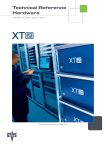
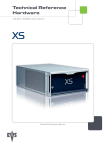


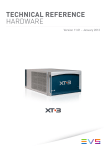
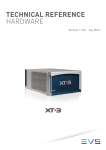
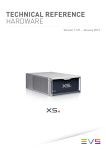
![2.8 conexión de varios servidores xt[2]](http://vs1.manualzilla.com/store/data/006305919_1-9948e093384d4040cdf0f68f445b7f43-150x150.png)

